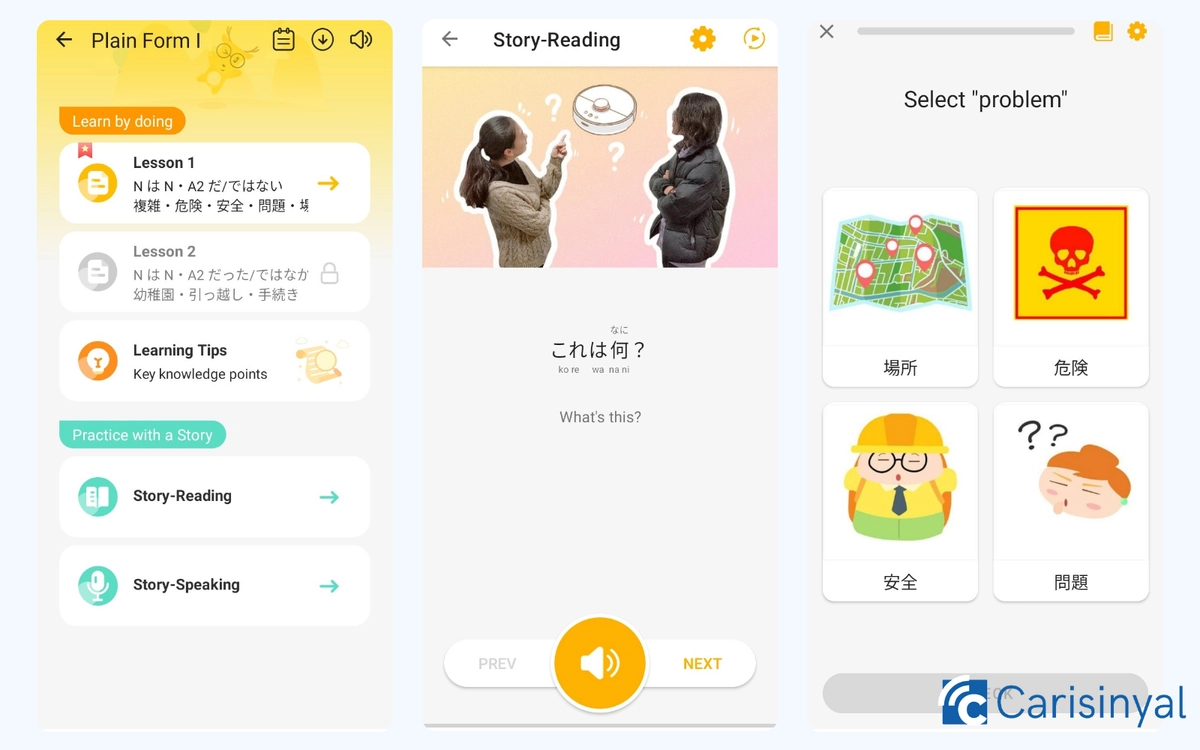8 Best Japanese Learning Apps on Android
Aside from Korean, Japanese is one of the most commonly learned languages in the world. Also, Japanese pronunciation is relatively easy. However, Japanese writing involves three scripts: kanji, hiragana, and katakana. Mastering all three takes time, especially kanji, which is particularly challenging.
Due to its difficulty, many people give up on learning Japanese. The complex writing system, combined with traditional study methods like language classes or textbooks, can sometimes feel tedious.
Fortunately, there are more engaging ways to learn Japanese without getting bored. One of the best options is using mobile apps. This time, the Carisinyal team has compiled a list of the best Japanese learning apps for Android to help you on your journey!
1. LingoDeer

I really appreciate how LingoDeer structures its learning curriculum into well-defined levels. Users can choose from a beginner level (equivalent to JLPT N5), a pre-intermediate level (equivalent to JLPT N4), and an intermediate level covering JLPT N5 to N3.
Additionally, LingoDeer offers specialized learning options, such as commonly used travel phrases and a curriculum focused on mastering different Japanese alphabets.
This structured approach aligns with LingoDeer’s emphasis on in-depth grammar instruction. As a result, even beginners can grasp sentence structures, particles, and verb conjugations rather than just memorizing vocabulary and phrases.
Beyond grammar and vocabulary, LingoDeer also provides writing and speaking lessons. The app's audio for listening and speaking practice sounds natural since it features native speakers rather than synthetic voices.
Moreover, LingoDeer includes learning statistics to track progress. Users can monitor the number of words, phrases, and sentences they’ve learned, their XP, streaks, and even their weekly ranking on the leaderboard or among their followers.
Things I Like About LingoDeer:
- Provides an in-depth focus on grammar.
- Features a well-structured curriculum with different proficiency levels.
- Allows users to track their learning progress with statistics.
2. Hiragana Quest

Have you ever heard of the mnemonic learning method? Mnemonics is a memory technique that simplifies complex information by turning it into something easier to recall.
For example, you can create acronyms from the first letters of words, form funny sentences, or associate information with vivid images. These techniques help the brain retain knowledge more effectively by making it more engaging and familiar.
Hiragana Quest applies this method to help users learn the writing and pronunciation of Katakana, Hiragana, and Kanji more efficiently. The app uses creative stories and illustrations to reinforce letter shapes and sounds, making the learning process more intuitive.
This approach is far more effective than apps that simply display characters without any memory aids. By using mnemonic techniques, you’ll be able to remember Katakana, Hiragana, and Kanji for longer compared to traditional rote memorization.
Beyond pronunciation, Hiragana Quest also allows you to practice writing each character with the correct stroke order. Plus, all learning modules are accessible offline, so you can study anytime without needing an internet connection.
Things I Like About Hiragana Quest:
- Focuses on learning Katakana, Hiragana, and Kanji.
- Uses mnemonic methods to simplify the learning process.
- Includes conversation lessons for various everyday situations.
- Can be used offline.
3. Duolingo

When it comes to learning a foreign language, including Japanese, Duolingo is one of the top choices. The app makes learning feel more relaxed, almost like playing a quiz game.
Duolingo’s curriculum covers Katakana, Hiragana, and Kanji, along with vocabulary and phrases. These materials are taught through a repetitive quiz system, which reinforces memorization and understanding.
Although Duolingo doesn’t focus heavily on grammar, it is still an effective tool for mastering everyday Japanese.
Additionally, the app helps users practice pronunciation for various Japanese words and phrases. However, its speech recognition feature isn’t very precise, making feedback on pronunciation somewhat unreliable.
Things I Like About Duolingo:
- Light and fun learning approach, making it feel like playing a game.
- Allows users to learn Katakana, Hiragana, and Kanji while mastering various Japanese vocabulary and phrases.
- Users can practice listening, writing, speaking, and reading in Japanese.
Things to Consider About Duolingo:
- Does not focus on grammar.
4. Memrise

Memrise has unique Hear My Words feature, which uses videos of native Japanese speakers to help users grasp natural intonation and pronunciation more effectively.
The app also offers a well-structured curriculum, ranging from Beginner, Elementary, Intermediate, Advanced Intermediate, Advanced, to Mastery levels. However, unlocking each level requires earning points by completing and mastering the previous one.
Each tier consists of multiple learning stages, where users practice speaking, expand their vocabulary, and improve their listening skills for Japanese words and phrases.
Beyond the basics, Memrise also features a Conversation mode, which teaches real-life dialogues in everyday situations. These include ordering coffee, asking for Wi-Fi, or even participating in a meeting at a new workplace, making learning both practical and immersive.
Things I Like About Memrise:
- Uses videos of native speakers, helping users understand Japanese intonation and pronunciation more naturally.
- Offers a wide range of curriculum levels, even up to Mastery.
- The Conversation feature allows users to practice common daily conversations.
Things to Consider About Memrise:
- Cannot be accessed offline.
- Does not have writing practice features for Katakana, Hiragana, or Kanji.
5. Busuu

In addition to its standard learning curriculum, Busuu offers a unique Japanese language course with a manga theme—a fun way to immerse yourself in both the language and Japanese culture. Sounds exciting, right?
However, this manga-themed curriculum is only available with a premium subscription.
No worries! You can still use Busuu for free with its general learning curriculum, which focuses on vocabulary, phrases, and sentence structure. Plus, the app features a community forum where you can interact directly with native Japanese speakers.
Through this community, you can post writing or speaking exercises and receive real-time feedback from native speakers—helping you develop more natural and confident Japanese language skills.
Things I Like About Busuu:
- Offers manga-themed Japanese lessons, which are unique, though paid.
- The general learning curriculum is still accessible for free.
- Allows interaction with the Busuu community, including native speakers, to receive feedback and make Japanese skills feel more natural.
Things to Consider About Busuu:
- Some learning curriculums are only available with a premium subscription.
6. Hey Japan: Learn Japanese

Hey Japan has an irresistibly cute interface! The app lets you choose from various themes, including popular anime-inspired ones like Naruto, One Piece, and Doraemon. It also features an adorable mascot named Shibi, who serves as your learning companion.
Shibi will guide you through Japanese alphabets, vocabulary, phrases, and commonly used daily conversations. In addition, Hey Japan includes lessons on Japanese grammar, making it a well-rounded learning tool.
Before taking a quiz evaluation, you can first go through the theoretical material to grasp key concepts. And here’s some great news—Hey Japan offers an some languages option.
Things I Like About Hey Japan: Learn Japanese:
- Adorable app theme customization.
- Provides not only a general Japanese language curriculum but also Japanese grammar materials.
- Offers some languages option for instructions.
Things to Consider About Hey Japan: Learn Japanese:
- In-app ads appear after completing each lesson.
7. Bunpo

Bunpo is a versatile language-learning app that offers courses in Korean, Spanish, French, German, and of course, Japanese.
This app has a feature to customize your study duration, allowing you to choose between 5 to 30 minutes per day. Additionally, you can set your skill level, so the app tailors the curriculum and learning content specifically to your needs.
For Japanese learners, Bunpo provides structured levels, including Alphabet & Basic Vocabulary, JLPT N5, JLPT N4, JLPT N3, JLPT N2, and JLPT N1. I personally started with the Beginner level, and Bunpo provided materials covering the Japanese alphabet and essential vocabulary.
Despite its beginner-friendly content, Bunpo includes an interactive dialogue feature and an AI tutor for conversation practice.
However, access to the AI tutor requires a premium subscription. Free users can still benefit from a conversation translation tool and the Snap feature, which helps solve Japanese language problems with detailed explanations.
To unlock the Practice feature, which tests your comprehension, you must first complete three lessons. Each lesson includes material explanations and practice exercises, ensuring a well-rounded learning experience.
Things I Like About Bunpo:
- Extensive learning materials, including Japanese grammar.
- Integrated AI for conversation practice.
- Features a conversation translation tool.
- Users can complete Japanese exercises simply by using the camera.
- Learning materials can be accessed offline.
Things to Consider About Bunpo:
- Some features are only available with a premium subscription.
8. Todaii

If you're looking for a fresh way to learn Japanese, why not try reading the news? Todaii is a fantastic app designed to enhance your reading, listening, and grammar skills through interactive features.
With Todaii, you can learn Japanese by reading daily news articles curated from sources like NHK News. The app allows you to read and listen to news in Japanese, making it an excellent tool for immersive learning.
Even if the articles are in Japanese, Todaii provides an integrated dictionary and translation tool, allowing you to instantly look up the meanings of words or phrases. This speeds up comprehension and helps expand your vocabulary effortlessly.
For those preparing for the JLPT certification exam, the app offers an Exam feature, which includes practice questions for JLPT N5 to N1. Regular use of this feature can help familiarize you with the exam format and improve your test-taking skills.
Beyond news articles, Todaii also provides Japanese podcasts and videos as additional learning materials. These not only make learning more engaging but also sharpen your listening skills. As a bonus, you'll gain deeper insights into Japanese culture through these resources.
Things I Like About Todaii:
- The packaging of Japanese language learning is very unique.
- It offers practice questions for the JLPT.
- Engaging multimedia content that also enriches Japanese language knowledge.
Things to Consider About Todaii:
- Users must register an account to access its free features.
- Some features are only available with a subscription.
All of the Japanese learning apps mentioned above are great alternatives for those who don’t have the time to attend formal language courses.
With these apps, you can learn more practically, effectively, and efficiently—all at your own pace. Plus, they are more budget-friendly compared to traditional language classes.
So, have you tried any of these Japanese learning apps? Which one is your favorite?

